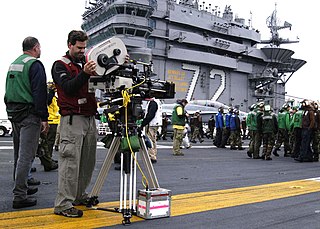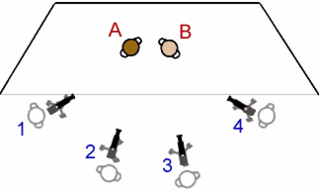Related Research Articles
In film and video, a cutaway is the interruption of a continuously filmed action by inserting a view of something else. It is usually followed by a cut back to the first shot. A cutaway scene is the interruption of a scene with the insertion of another scene, generally unrelated or only peripherally related to the original scene. The interruption is usually quick, and is usually, although not always, ended by a return to the original scene. The effect is of commentary to the original scene, frequently comic in nature.

Film editing is both a creative and a technical part of the post-production process of filmmaking. The term is derived from the traditional process of working with film which increasingly involves the use of digital technology.

A film crew is a group of people, hired by a production company, for the purpose of producing a film or motion picture. The crew is distinguished from the cast, as the cast are understood to be the actors who appear in front of the camera or provide voices for characters in the film. The crew is also separate from the producers, as the producers are the ones who own a portion of either the film studio or the film's intellectual property rights. A film crew is divided into different departments, each of which specializes in a specific aspect of the production. Film crew positions have evolved over the years, spurred by technological change, but many traditional jobs date from the early 20th century and are common across jurisdictions and filmmaking cultures.

Stanley Kubrick was an American film director, producer, screenwriter, and photographer. He is frequently cited as one of the greatest filmmakers in cinematic history. His films, which are mostly adaptations of novels or short stories, cover a wide range of genres and are noted for their realism, dark humor, unique cinematography, extensive set designs, and evocative use of music.

A cinematographer or director of photography is the person responsible for the photographing or recording of a film, television production, music video or other live action piece. The cinematographer is the chief of the camera and light crews working on such projects and would normally be responsible for making artistic and technical decisions related to the image and for selecting the camera, film stock, lenses, filters, etc. The study and practice of this field is referred to as cinematography.

A film transition is a technique used in the post-production process of film editing and video editing by which scenes or shots are combined. Most commonly this is through a normal cut to the next shot. Most films will also include selective use of other transitions, usually to convey a tone or mood, suggest the passage of time, or separate parts of the story. These other transitions may include dissolves, L cuts, fades, match cuts, and wipes.
Filmmaking is the process by which a film is made. Filmmaking involves a number of complex and discrete stages, including an initial story, idea, or commission. It then continues through screenwriting, casting, shooting, sound recording, pre-production, editing, and screening the finished product before an audience that may result in a film release and an exhibition. Filmmaking takes place in many places around the world in a range of economic, social, and political contexts. It uses a variety of technologies and cinematic techniques.
Second unit is a discrete team of filmmakers tasked with filming shots or sequences of a production, separate from the main or "first" unit. The second unit will often shoot simultaneously with the other unit or units, allowing the filming stage of production to be completed faster.

Wong Tung Jim, A.S.C., known professionally as James Wong Howe (Houghto), was a Chinese-born American cinematographer who worked on over 130 films. During the 1930s and 1940s, he was one of the most sought after cinematographers in Hollywood due to his innovative filming techniques. Howe was known as a master of the use of shadow and one of the first to use deep-focus cinematography, in which both foreground and distant planes remain in focus.
Television crew positions are derived from those of film crew, but with several differences.

Deep focus is a photographic and cinematographic technique using a large depth of field. Depth of field is the front-to-back range of focus in an image, or how much of it appears sharp and clear. In deep focus, the foreground, middle ground, and background are all in focus.
This article contains a list of cinematic techniques that are divided into categories and briefly described.
A script supervisor is a member of a film crew who oversees the continuity of the motion picture including wardrobe, props, set dressing, hair, makeup and the actions of the actors during a scene. The notes recorded by the script supervisor during the shooting of a scene are used to help the editor cut the scene. They are also responsible for keeping track of the film production unit's daily progress. The script supervisor credit typically appears in the closing credits of a motion picture. Script supervisors are a department head and play a crucial role in the shooting of a film. It is the script supervisor's job to monitor the camera shots, seeking to maintain coherence between the scenes.

The multiple-camera setup, multiple-camera mode of production, multi-camera or simply multicam is a method of filmmaking and video production. Several cameras—either film or professional video cameras—are employed on the set and simultaneously record or broadcast a scene. It is often contrasted with a single-camera setup, which uses one camera.
In filmmaking, a pick-up is a small, relatively minor shot filmed or recorded after the fact to augment footage already shot. When entire scenes are redone, it is referred to as a re-shoot or additional photography.
In the post-production process of film editing and video editing, a cut is an abrupt, but usually trivial film transition from one sequence to another. It is synonymous with the term edit, though "edit" can imply any number of transitions or effects. The cut, dissolve and wipe serve as the three primary transitions. The term refers to the physical action of cutting film or videotape, but also refers to a similar edit performed in software; it has also become associated with the resulting visual "break".
Articles related to the field of motion pictures include:
Lou Lombardo was an American filmmaker whose editing of the 1969 film The Wild Bunch has been called "seminal". In all, Lombardo is credited on more than twenty-five feature films. Noted mainly for his work as a film and television editor, he also worked as a cameraman, director, and producer. In his obituary, Stephen Prince wrote, "Lou Lombardo's seminal contribution to the history of editing is his work on The Wild Bunch (1969), directed by Sam Peckinpah. The complex montages of violence that Lombardo created for that film influenced generations of filmmakers and established the modern cinematic textbook for editing violent gun battles." Several critics have remarked on the "strange, elastic quality" of time in the film, and have discerned the film's influence in the work of directors John Woo, Quentin Tarantino, Kathryn Bigelow, and the Wachowskis, among others. While Lombardo's collaboration with Peckinpah lasted just a few years, his career was intertwined with that of director Robert Altman for more than thirty years. Lombardo edited Altman's 1971 film McCabe & Mrs. Miller (1971), which had "a radical approach to the use of dialogue and indeed other sound, both in and beyond the frame." Towards the end of his career Lombardo edited Moonstruck (1987) and two other films directed by Norman Jewison. While his editing is now considered "revolutionary" and "brilliant", Lombardo was never nominated for editing awards during his career.
Arthur Eugene "Gene" Milford was an American film and television editor with about one hundred feature film credits. Among his most noted films are Lost Horizon, On the Waterfront, A Face in the Crowd, and Wait Until Dark.
This glossary of motion picture terms is a list of definitions of terms and concepts related to motion pictures, filmmaking, cinematography, and the film industry in general.
References
- Notes
- ↑ According to David Mamet, the director's job is to break the script down into a list of shots. [11] Directors tend to focus on shooting these shots, eliciting performances from their actors, and creating interesting visuals. Few directors are trained to shoot coverage. [12]
- Citations
- 1 2 3 4 5 6 7 LoBrutto 2012, p. 18.
- ↑ LoBrutto 2012, p. 34.
- ↑ Rosenberg 2018, p. 69.
- ↑ Brown 2016, pp. 66–71.
- 1 2 Brown 2016, p. 66.
- 1 2 3 Brown 2016, p. 71.
- 1 2 LoBrutto 2012, p. 17.
- ↑ Ascher & Pincus 2007, p. 325.
- ↑ LoBrutto 2012, pp. 17–18.
- ↑ Rosenberg 2018, pp. 91–92.
- ↑ Mamet 1991, p. 5.
- ↑ Rosenberg 2018, p. 106.
- ↑ Rosenberg 2018, p. 104.
- ↑ Rosenberg 2018, p. 91.
- ↑ LoBrutto 2012, p. 69.
- 1 2 3 4 Rosenberg 2018, p. 92.
- ↑ Brown 2016, p. 67.
- 1 2 3 Brown 2016, p. 68.
- ↑ Schumach, Murray (August 28, 1960). "HOLLYWOOD USAGE Experts Analyze the Pros and Cons Of Time-Tested 'Master' Scene". The New York Times . Retrieved April 6, 2021.
- 1 2 Rosenberg 2018, pp. 105–106.